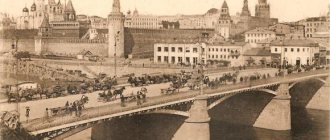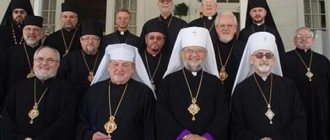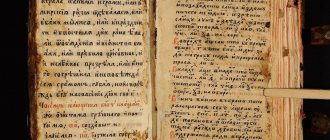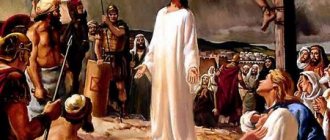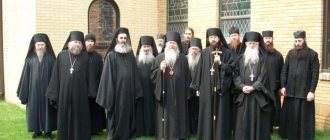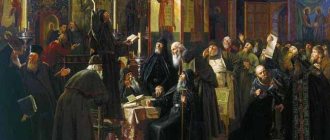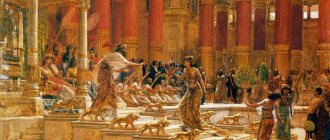Until now, the best example of a legal system is considered to be Roman law, according to which, among other things, Byzantium lived. However, this does not mean that in other countries things were worse with legal documents and regulations.
In Rus', civil law was still correlated with folk law. And only after baptism, when the church court was established, did the history of Russian judicial practice begin.
The Church court in Rus' had enormous powers. Those cases that in Byzantium itself would have been considered in a civil court, in Rus' were considered by clergy.
According to the statutes of princes Vladimir and Yaroslav, all civil relations relating to morality and religion were submitted to the episcopal court. The Church defended parental rights, the rights of children, and conducted cases concerning family relationships.
Sources of Old Russian law
Until the 9th century, it is impossible to establish the exact structure and provisions of Russian law. But we know its main sources:
- Legal custom (or “common” law). These are laws and rules that have evolved over centuries, under the influence of customs and traditions prevailing in the region. The common law in Russian-Byzantine treaties is called the Russian Law.
- Contracts. Russian-Byzantine and other international treaties, agreements between principalities and even private agreements between merchants have reached our times. These are also legal sources that allow us to trace the process of formation of law in Ancient Rus'.
- Judicial precedents. These are decisions of the princely court on certain cases that were taken as a standard for considering similar cases. This is interesting: case law has survived to this day in England and the USA.
- Legislation. The first written laws began to appear on the territory of the Old Russian state only in the 10th century, after baptism.
Court under Alexander III
The reforms of Alexander III are called counter-reforms. His counter-reforms consisted of revising many of the achievements of the previous course in such important spheres of Russian society as zemstvo, city government, courts, education and the press. The main reason for the sharp change in government policy in the early 80s. XIX century was not only the unique personality of Alexander III and his associates. An important role was played by the tense internal political situation caused by the terrorist activities of the People's Will, and above all by the assassination of Alexander II. The death of the emperor made a stunning impression on the country: Alexander II became not only a king-liberator, but also a king-martyr. The public consciousness connected this tragedy with the “liberal” activities of the sovereign, which “released dark forces,” which ultimately led to a terrible denouement. Memories of the regicide predetermined the attitude towards the revolutionary and liberal forces of the country not only from the authorities, but also from most of the enlightened society, tuned to the need to “establish order.”
Alexander III
The judicial statutes of 1864 continued to operate successfully under Alexander III. But in legal proceedings in political cases, openness was limited: publication of reports on political trials was prohibited. All cases of violent actions against officials were removed from jury trials. Significant changes took place in the lower judicial bodies: justices of the peace, who, in addition to handling minor cases, resolved controversial issues between peasants and landowners, were largely eliminated. They survived only in three large cities - Moscow, St. Petersburg and Odessa. Justices of the peace by zemstvo district chiefs , whose positions were provided exclusively to nobles with a high property qualification. Unlike the magistrate's court, which was entrusted with achieving agreement between peasants and landowners, zemstvo leaders resolved all controversial issues individually, with an eye on the local state administration.
Old Russian legislation
Secular legislation existed in Rus' before, simply in the form of customary law. But church legislation, independent of the decisions of the Kyiv prince, was brought from Byzantium. The Greeks adopted the nomocanon: decrees of church councils, as well as the eclogue - secular laws for criminal and civil courts.
All laws adopted from the Byzantines were combined into one general code - the Helmsman's Book. And from the 11th century. Russian Pravda becomes the main source of legislation.
This legislative document very accurately reflects the legal reality of Rus' in the 11th-12th centuries, but this reflection cannot be called complete. In Russian Pravda, private legal relations have been formed that affect the material interests of citizens. Moral standards were entirely within the authority of the church.
In 996, Prince Vladimir Krasno Solnyshko built a cathedral church in Kyiv and allocated a tenth of his income for its maintenance. Information about this remained not only in chronicles; the princely oath is found in the surviving “Church Charter of Vladimir”.
What does this charter say? The prince asks his descendants to inviolably observe the decrees of the ecumenical councils and the laws of the Greek kings. That is, the document is based on the Greek Nomocanon.
The charter was also included in the Novgorod Helmsman’s Book. It was in it that the oldest list of the Vladimir charter was preserved, which has survived to this day. A thick layer of edits, alterations, insertions and additions gives us reason to believe that the charter was in effect (and changed) for a long time.
The first article of the Regulations “on the canonical foundations of the judicial system of the Russian Orthodox Church” proposes non-canonical foundations of the judicial system. The position was cobbled together in the legal department of the MP, like a swallow’s nest, from individual pieces, lumps and twigs, borrowed from various codes of the Civil Code, Civil Procedure Code, Code of Criminal Procedure of the Russian Federation, even a couple of texts from church canons. Church canons form a fundamentally different structure of the church court, which contradicts the Regulations.
Church canons know the court of bishops. 12 bishops judge the bishop; the priest is judged by six bishops and his own; three bishops judge the deacon. In case of disagreement, more bishops are invited. (Ap.74. Carth.12; 29. Deut.6). Theoretically, the trial of a bishop is permitted by the Regulations. In practice, a trial of a bishop is not permitted. The provision abandoned the trial of bishops over clergy. The diocesan bishop judges clergy and laity individually, which leads to arbitrariness.
The Regulations lack the fundamentals and purpose of legal proceedings. The cutters from the legal department of the Moscow Patriarchate stitched together the church code from the concepts of civil, criminal and administrative law, changing the meaning of many provisions, sometimes even to the contrary, introducing laws of their own creation, framed with the sparkles of canon law. Typically, courts differ in their tasks and methods of performing them. Civil, arbitration and arbitration courts resolve disputes between the plaintiff and the defendant. Criminal and administrative courts sentence defendants for offenses. The provision combined incompatible tasks and mixed the statuses of the participants in the process. The bishop proposed to adopt a new Charter in the Parish of the Holy Myrrh-Bearing Women. The proposal divided the parish into supporters and opponents. The court could resolve the dispute by recognizing the right of each party to free expression of will in accordance with the law of the Russian Federation and the charter of the Parish.
The court did not identify the plaintiff in the dispute and did not invite him to the court hearing. Having invited the defendants, the court acted in the interests of the plaintiff and accused the defendants of an offense for expressing an opinion about the Parish Charter.
The position is contradictory, the articles are unspoken, vague, and often ambiguous. It is impossible to determine the foundation on which the Regulations on the Church Court grew. The canonicity of the document is limited by its conciliar approval. Of the three courts established by the Charter of the Russian Orthodox Church, only two are practically used: the first and second for clergy and laity; the second and third are for bishops. There is no supervisory authority. The main task of the court - to administer justice - has not been set.
The task of legal proceedings is established by Article 2 of the Regulations. It is called: “The purpose of church courts” and consists of one point: “Church courts are intended to restore the broken order and structure of church life and are designed to promote compliance with the sacred canons and other institutions of the Orthodox Church.” The content of the first task, firstly, is broad to the point of uncertainty: “intended to restore order and preserve the order of church life.” The scope of the task and its specific content are unclear. Does this include the restoration of justice and truth? Will the court protect the weak from the strong, the offended from the offender, the right from the rapist? The position is not responding. Secondly, it imposes responsibilities on the court that it obviously cannot fulfill. The judiciary examines the case and makes decisions. The execution of decisions is carried out by the executive branch.
The second task - “to promote compliance with the sacred canons and other institutions of the Orthodox Church” - points to “canons and institutions” as the object of the court’s activities. The position ignores man as the object of the economy for whose sake Christ was crucified. “Seek the truth, save the oppressed, defend the orphan, stand up for the widow. Zion will be saved by justice” (Is. 1; 17, 27).
The Charter of the Russian Orthodox Church establishes a church court (Chapter 1, 8) and prohibits clergy and laity from applying to government bodies and civil court (Chapter 1, Section 9). The provision on the church court does not set the task of protecting people - clergy and laity. Where should the offended and offended go? The provision excluded the main task expressing the nature of the court - justice. A court that does not deliver justice is “thrown out to be trampled under foot by men, like unsalted salt” (Matthew 5:13).
Part 4. Privatization of the judiciary
The first part of Article 3 of the Regulations indicates the specific owners of judicial power in the Russian Orthodox Church: “the fullness of judicial power in the Russian Orthodox Church belongs to the Council of Bishops.” The first owner of the judicial power is the Council of Bishops. The provision gives the right to “the Holy Synod and the Patriarch to exercise judicial power in the church,” without specifying whether they are the owners of the judicial power or whether this power is delegated to them by the Council of Bishops. According to the provision, the owners of power can dispose of the judicial power independently and individually or delegate it to other bodies, reserving the right to approve decisions.
The Judicial Power of the Patriarch and the Synod is defined by the Regulations ambiguously.
The provision does not say that “the Synod and the Patriarch have full judicial power,” like the Council of Bishops. The position is expressed more modestly: “they exercise judicial power,” allowing one to think that the Patriarch and the Synod are not, like the Council, sources of judicial power in the church.
However, in the next line, speaking about the delegation of judicial power to the General Church Court (hereinafter - the OCC), the Regulations call the source of judicial power not the Council of Bishops, but the canonical power of the Synod and the Patriarch. It remains unclear how many owners of the judiciary are recognized in the Russian Orthodox Church: one or three?
The OCS turns out to be the executive body of the judiciary, performing a technical task delegated by the owners of the judiciary. The OCS cannot arbitrarily initiate a case; its decisions do not have legal force until approved by the Patriarch, who can cancel or change the decision of the OCS. His decision takes effect immediately. The crafty word “delegation” disguises the collegiality of the OCS as the sole court of the owner of the judicial power.
The second part of Article 3 of the Regulations indicates the sole owner of judicial power in the diocese: “The fullness of judicial power in the diocese belongs to the diocesan bishop.” In cases of church violations, the bishop can make a judicial decision himself or refer the case to the diocesan court. The decisions of the diocesan court come into force through approval by the bishop. The bishop can reverse or change the court's decision. The bishop's decision takes effect immediately. “The judicial power of the diocesan court derives from the canonical power of the diocesan bishop, which the diocesan bishop delegates to the diocesan court.”
The provision does not cite specific canons to justify the ecclesiastical legal principles. The canons do not confirm the autocracy of the bishop. The provision places the bishop's private right to judicial power at the basis of church legal proceedings.
The further text of the Regulations details and deepens this right.
“Having abandoned the Eucharistic source of the bishop’s power, the church consciousness had to borrow from empirical life the principle of law to justify the bishop’s power. The idea of legal authority led to the establishment of legal relations between him and the members of his church. Hierarchical ministry, flowing from the very essence of the Church, received a justification that is not contained in the Church at all. The power of the bishop, based on law, led to the idea of legal limitation of this power at the Moscow Council of 1917-18.” (Afanasiev Nikolai, Archpriest “Church of the Holy Spirit.” Riga, 1994, p. 2).
Statutes of the Russian Orthodox Church 1988, 2000 and 2011. abolished all legal restrictions on the power of the bishop and the controlling power of the Local Council. The Regulations do not address the question of the ecclesiastical justification of autocracy. It is not clear how the “fullness of the judicial power of the diocesan bishop” differs from the fullness of his administrative power. In both cases, only punitive sanctions are applied and there is no responsibility for abuse of power. Why should unlimited power be supplemented by the dubious institution of the “church court”?
The provision does not pose either an ecclesiastical or legal task of legal proceedings. Let us turn to that “empirical life” from which “church consciousness borrowed the principle of law.” Let's see how she poses the task of the court.
The Constitution of the Russian Federation justifies the judiciary with the duty of the state to protect the rights and freedoms of man and citizen (Article 46.1). “Man, his rights and freedoms are the highest value. Recognition, observance and protection of human and civil rights and freedoms is the duty of the state” (Article 2).
“No one can be deprived of the right to have his case examined” (Article 47, 1).
“All are equal before the law and the court” (Article 19:1-3).
The above provisions of the Constitution of the Russian Federation reflect two evangelical principles:
1. The principle of justice: “in everything, as you want people to do to you, do so to them; for this is the law and the prophets” (Matt. 7:12).
2. Hierarchy of values: man is a primary value, and law is a secondary value. “The Sabbath is for man, not man for the Sabbath. Therefore the Son of Man is Lord of the Sabbath” (Mark 2:27-28).
In contrast to the Constitution of the Russian Federation, the Charter of the Russian Orthodox Church introduces into the church the principle of inequality of Christians before the law and the court (Charter Chapter 7, paragraph 8;).
The position does not seek evangelical justifications, does not pretend to be fair, and omits the biblical idea of justice reflected in the Apostolic and Ecumenical canons and rules of the Holy Fathers.
The conditions and principles stated by the Regulations determine the quality of diocesan justice. Its effectiveness is revealed by practice of application.
The ecclesiastical nature of the Regulations should be assessed from the humane perspective of the Gospel (Matthew 26, 31-46).
The provision is not based on the “sacred canons”. A blind reference to the “fundamentals of church justice” masks a deviation from the canonical tradition of the Orthodox Church. The canons represent the rules of life and faith. The fathers accepted them in parallel with the dogmas. The accepted dogma was reinforced by liturgical and canonical practice. The legislative norms reflected the dogmatic teaching about the Holy Trinity, the Incarnation and “the Church of the Lord and God, which He purchased with His own blood” (Acts 20:28). The canonical tradition does not give ecclesiastical power to property and does not recognize the dictatorship of the bishop.
The “Decree on Diocesan Administration” dated February 22, 1918 states:
“The bishop uses, by Divine authority, the fullness of hierarchical power in matters of religious and moral teaching, sacred rites and pastoral care.”
We find a similar text in the Charter of the Russian Orthodox Church (chap. 10, 11). It also implies a “Divine Authority” of power that the bishop “uses.”
The position declares a text that has a formal similarity with the Charter (10.11) and differs significantly in the understanding of the nature of the power of the bishop. Unlike the Statutes of the All-Russian Orthodox Church and the Russian Orthodox Church, the Statute transfers judicial power into the ownership of the bishop. The bishop privatizes and “delegates power to the diocesan court.” "Divine authority" is not implied where the bishop himself turns out to be the Source of "canonical authority" which "flows" from him.
Being a by-law of the Charter of the Russian Orthodox Church, the Regulations conflict with it. While recognizing the bishop as the source of legal authority, the Regulations did not substantiate the stated principle. Legal authority has never received theological justification in the church, since the roots of law remain outside the boundaries of the church.
In historical retrospect, power has one of three bases:
1. In monarchies, power had divine sanction. The ruler was either a god, like the Roman Caesar and the Egyptian pharaoh, or an anointed one of God, like the biblical kings or the Byzantine and Russian autocrats. Anointing is not included in the sacrament of ordaining a bishop. The Eastern Church, unlike the Western Church, does not call the bishop the vicar or anointed of God.
2. A democratic state is based on a liberal value system. It places the individual at the center of legislation. State power is justified by the interests, rights and freedoms of man, as we saw in the Russian Constitution.
In the first case, the source of power is God, in the second - man.
3. The head of the Church is the God-Man: “He will give him the head above all the Church” (Eph. 1:22). To Jesus Christ belongs the fullness of power: “To him be the glory and the dominion forever” (1 Pet. 5:11). The authority of the bishop can be justified by the command: “feed my sheep” (John 21:16). This command has the condition: “Do you love Me?” The power of love is grounded in Christ. On its basis, shepherding arises. “There is one flock and one shepherd” (John 10:16). Christ does not give the sheep as property to the bishop. He entrusts the sheep to his care and will demand an account. This is how the Eastern Church understood the power of the bishop. The bishops of the Russian Orthodox Church consider themselves masters of the flock, leaving no room for Christ.
The Lord clearly defined the nature of power in the church: “Kings rule over nations and those who control them are called benefactors. But you are not so: but whoever is the greatest among you must be like the younger, and he who is in charge like one who serves... I am among you as one who serves” (Luke 22:25, 27). “If I, the Lord and Teacher, have washed your feet, then you should also wash one another’s feet. For I have given you an example” (John 13:14). The power of violence divides. The power of love connects.
The provision did not justify the legal authority of the bishop. Power that “stems” from the personal will of a person does not need justification. Autocracy justifies itself. A unique system of values emerges in which power has no basis either in God or in man. It is based on the autocratic function into which the Regulations transform the bishop. Inexorable logic leads to one of two justifications for self-government: either the humanistic idea of a superman, or the cult of a man-god. In this system, it is quite logical to deny the interests, rights and freedoms of a Christian. With the same necessity, Divine power is excluded. Power has only one source and one owner. It is wicked to suppose that God shares power with the bishop. If we recognize the Regulations as a church document, a discrepancy arises. Rights and freedoms belong to the bishop. Others are obliged to fulfill their duty.
The situation neglects justice, for the author neglects the human face, in which the Face of Christ is reflected: “as you did it to one of the least of these brothers of mine, you did it to me” (Matthew 25:40). The position considers the more important task of establishing order: “to protect the flock of the Church of God from heresies, schisms, disorder and disorder, to help repentance, correction and salvation of criminals, having in mind the good of the holy Russian Orthodox Church and the salvation of neighbors” (Oath of Judge).
These global goals do not include concern for the rights, dignity and destiny of the Christian. Man can be neglected in the name of high goals: “It is better for us that one man should die for the people, than that the whole nation should perish” (John 11:50). Jesus sacrifices Himself. Caiaphas proposes to sacrifice Jesus. The result is the same: “The Son of Man comes, just as it is written about Him.” But different morals: “Woe to that man to whom the Son of Man is betrayed” (Matthew 26:24). What to prefer: sacrifice or expediency? The crafty wisdom of Caiaphas still finds followers in the Russian Orthodox Church. The Church of Christ is a Divine-human organism. She cannot be deified or dehumanized.
Part 5. The secrecy of the church court.
The consideration of cases in the church court is closed. (“Regulations on the Church Court of the Russian Orthodox Church MP”, hereinafter referred to as the Regulations, paragraph 2 of Article 5;). The principle of closed court is confirmed by the Charter of the Russian Orthodox Church: “The proceedings in all church courts are closed (Chapter 7, Art. 9).
The concept of “closed court” is not explained in more detail. The limits to which the secrecy of what is happening at court hearings extends are not specified. It is known from practice that the presence of the press and any persons who are not participants in the process is excluded at the court hearing.
If the doors are locked, it is impossible to find out what is happening behind these doors: is God's truth being created or are tears being shed that are invisible to the world?
The privatization of the judiciary by the bishop raises doubts. Article 3, paragraph 2 of the Regulations gives the diocesan bishop “full judicial power” not for use, but for ownership, stating that the power “belongs to the bishop.”
The “Decree on Diocesan Administration” dated February 22, 1918 states: “the bishop enjoys, by Divine authority, the fullness of hierarchical power in matters of religious and moral teaching, sacred rites and pastoral care.” “Use” and “belong” are different concepts with different consequences: the bishop is responsible for the use of power. If the power belongs to the bishop, there is no responsibility for its use. Christ says: “All authority in heaven and on earth has been given to me.” Authority “belongs” to Christ, for “the Father gave all authority to the Son.” God did not give all power to the bishop, but allowed it to be used “by Divine authority.” If power "belongs" to the bishop, he becomes a power thief. This ungodly expression compromises the entire church document.
The diocesan bishop can make a judicial decision himself or entrust it to diocesan judges. In both cases, the decision comes into force if the bishop approves it with his authority.
It should be noted that the bishop simultaneously exercises full executive power in the diocese (Charter of the Russian Orthodox Church, Chapter 10, paragraphs 11, 14).
There are no criteria distinguishing the judicial and executive powers in the actions of the bishop. Justice is deprived of the main condition - the independence of the court. The court has been placed at the disposal of the executive branch. The dependence of the court on the executive branch precludes appealing its decisions in court. If decisions of the executive branch cannot be appealed in a church court, then the court does not protect the rights of clergy and laity in cases of conflict with the executive branch. The court does not burden itself with the task of justice, limiting itself to the narrow task of “restoring the order of church life and observing the canons and regulations” (Regulations, Art. 2).
The Charter of the Russian Orthodox Church introduces the principle of inequality of Christians before the law and the court: “The decisions of church courts that have entered into legal force, as well as their orders, demands, instructions, summonses and other instructions are binding on all clergy and laity without exception” (Charter of the Russian Orthodox Church, Chapter 7, Art. 8).Only for clergy and laity are the orders of the church court obligatory. Bishops are not included among the persons obliged to recognize the decisions of the ecclesiastical court.
The statute also prohibits clergy and laity from going to civil court. The ban does not apply to bishops (Charter of the Russian Orthodox Church, Chapter 1, Article 9). There is complete irresponsibility of the bishop in the moral and legal field of the Russian Orthodox Church, which fundamentally contradicts the rules of the Universal Church.
In the apostolic and ecumenical canons all the people of God are placed on equal terms, and the bishop is the first to be called to account. Every canon begins with a bishop: “whether a bishop, or a presbyter, or a deacon, or anyone from the sacred list...” (Ap. 8).
The closed nature and dependent position of the court is aggravated by the absence of a body monitoring judicial activities. The court does not allow the parties to familiarize themselves with the records of court hearings, interrogations, witness statements and other materials of the case.
The bishop carries out and controls the judicial process, that is, controls himself. In the absence of a body monitoring the court's compliance with the rules of legal proceedings, objective verification of the court's activities is excluded, and the unity of the judicial system of the Russian Orthodox Church, declared by the Regulations, is not ensured (Regulations, paragraph 1 of Article 4).
The provision does not provide for a defense attorney for the accused, who cannot defend themselves because they are not familiar with the peculiarities of the process in a church court and church canons. The court makes a decision not in the interests of justice, but in the interests of the church, which judges may understand differently. (Regulations, judge's oath).
Therefore, the accused may be convicted not of an offense, but for the inability to prove his innocence due to his own lack of rights and canonical incompetence. In church court there is a presumption of guilt. The diocesan bishop is not only a judge, but also an accuser. He issues an order to initiate a case and transfers it to the diocesan court for consideration (Regulations, Art. 33).
Given the stated conditions of the trial, it can be expected that, behind closed doors, everyone accused by the bishop will be convicted.
Part 6. Establishment and competence of the court.
The bishop establishes the Diocesan Court: “Diocesan courts are created by decision of the diocesan bishop (Regulations, Art. 23; Charter of the Russian Orthodox Church, Chapter VII).” The link is erroneous. The Charter of the Russian Orthodox Church does not contain such a provision.
The diocesan court consists of five priests. The bishop appoints a chairman, deputy, secretary and recommends other members. The bishop's recommendation is not disputed. It would be more accurate to write: all judges are appointed and dismissed by the diocesan bishop. Judges do not receive a document confirming their status, which allows for substitution. Upon taking office, judges take an oath.
The bishop determines the jurisdiction of the court. The diocesan court considers cases involving charges against clergy and laity, “which require investigation at the discretion of the diocesan bishop” (Regulations, Art. 24).
The bishop initiates a case in court on the basis of a statement or without it (Regulations, Art. 33). A statement of church violation signed by the applicant is the canonical basis for initiating a case. The second part of Article 33, “a report of an ecclesiastical offense received from other sources,” is anti-canonical. The article does not specify which sources of information about church violations are allowed, by whom and how the legitimacy of the sources is investigated.
The second part of Article 33 contradicts Article 34 and paragraph 3 of Article 18 of the Regulations and the ecumenical canons given therein. The canons prohibit the acceptance of anonymous statements and evidence: “If a church court attracts witnesses, there must be at least two of them (Apostolic Canon 75; Canon 2 of the Second Ecumenical Council). In this case, the following are not subject to being brought as witnesses: persons who are outside church communion (with the exception of cases on charges of committing church offenses against one’s neighbor and Christian morality (Canon 144 of the Carthage Council; Apostolic Rule 75; Canon 6 of the Second Ecumenical Council); those who are legally incompetent in accordance with persons with state legislation; persons convicted by a church court for knowingly false denunciation or perjury (Second Ecumenical Council, rule 6); clergy according to circumstances that became known to them from confession" (Regulations, 33.2).
The application of the second part of Article 33 contradicts paragraph 3 of Article 16 of the Regulations: “The applicant is warned of canonical responsibility for knowingly false denunciation of an allegedly committed church offense.” If there is no applicant, there is no one to bear responsibility for false information.
The second part of Article 33 establishes a search process, which in history has received the name “holy inquisition”. The Inquisition court does not investigate the offense, but the life and activities of the specific person against whom the accusation is brought. Using interrogation, the court identifies signs of any offense in the life and activities of a person that has caused the bishop’s displeasure. The ecumenical canons of the church do not allow the investigative process, when the accusation against a person is sought through his interrogations.
The decision of the diocesan court in the case must be made no later than one month from the date the diocesan bishop issues an order to transfer the case to the diocesan court. The time period within which the bishop, having received the application, transfers the case to the court is left without attention, since the transfer of the case to the court is left to the discretion of the bishop.
The provision in Article 8 and Article 9 on termination of powers and self-recusal of judges ignores the universal principle of recusal of judges from accused persons. “Judgment cannot be carried out on the basis of enmity, partiality and man-pleasing” (Carth. 16). Contrary to the canon, the Regulations do not provide for the recusal of judges at the request of the accused. The canon allows the accused to challenge suspected judges (Kiril.1). The canons allow the accused to elect judges for his trial (Carth. 107; 113). The canonical principles are based on humanity, justice and the objectivity of church decisions, in contrast to the Statute of the MP, which is concerned only with respecting the interests of the local bishop.
Court documents.
The regulation establishes and voices the legality, form and content of three judicial documents: 1. Summons to court; 2. Protocol of the court session; 3. A court decision that “overrides” the bishop’s resolution. The Regulations did not establish any other court documents. 1. The summons is served on the participants in the process within a time limit that ensures timely appearance in court. The summons contains: the name and address of the church court; an indication of who the addressee is called as; time and place of the meeting; information about the case (Regulations, art. 11-12).
2. The minutes of the court session contain information on the case. It is signed by the chairman and secretary of the court within three days.
The minutes of the court meeting indicate: the date and address of the meeting; Name and composition of the court, case number; names of those present, participants and their explanations of witnesses, documents, examinations, material evidence, date (Regulations, Art. 43-44).
3. The decision of the church court establishes the fact of the offense and the guilt of the accused. Gives a canonical assessment of the offense, according to the norms of church law. Determines the canonical punishment for the accused. At the court hearing, the chairman announces the decision to the parties and explains the procedure for approval and appeal. If the parties are absent from the hearing, the court secretary shall inform the absent parties within three working days about the decision made.
The decision of the church court contains: date; name and composition of the church court; description of the merits of the case; a conclusion about the guilt of the accused person and a canonical assessment of the act (using the norms of church law); recommendation of canonical punishment. The decision of the church court must be signed by all judges of the church court who took part in the meeting. A judge of a church court who does not agree with the decision made may express a dissenting opinion in writing, which is attached to the case materials, but is not made public (Regulations, Articles 45-46).
The Regulations do not provide for any court documents other than the “summons”, “protocol” and “decision”. However, in practice, new documents appear, the form, content and purpose of which are not defined by the Regulations, for example: “Private determination”, as well as a Letter signed by the secretary of the OCS with reference to the opinion of “members of the OCS”, but without court details, without seal and signatures of members about the refusal of the UCC to respond to the appeal. Thus, ecclesiastical legal proceedings allow illegitimate documents. This applies, first of all, to court decisions. The phrase is alarming: “the court secretary, within three working days, informs those who are absent about the decision made” (Regulations, paragraph 3 of Article 45). Why “information about the Court Decision”, and not the “Court Decision” itself? You can ignore this phrase. In practice, a convicted person who was not present at the meeting is not informed of the decision, but information about the Decision, which may have other names: “Extract from the Decision”, “Message about the decision” and other names not provided for by the Regulations.
An interesting fact admitted by the Pskov diocesan court. At the end of the court hearing, held on June 3, 2011, the President of the Netreba court, as expected, read out the Decision, according to which six parishioners were convicted. On August 22, 2011, the text of the Decision signed by Netreba and other judges was handed over to the convicts. In the text of the Decision there were no longer six, but eleven convicts.
Metropolitan Eusebius wisely preserved the uncertainty in the resolution that approved both court decisions: “The court decision of June 3, 2011 on the removal from the Parish Assembly of individuals who disagree with the charter is APPROVED on 08/02/2011. Metropolitan EUSEBIUS"
It remains a mystery: which of the two court decisions on the same case, dated on the same date, was approved by the Metropolitan? The OCS ignored this riddle. Regarding the Protocol of the court session, it should be noted that it is not provided for review by the participants in the process. The convicted were able to familiarize themselves with the Protocol of the court session of the Pskov Diocesan Court dated 05/03/11 only in the Pskov City Court, where the claim of parishioners against the Pskov Diocese was considered.
What was included in this charter?
Definition of ecclesiastical status. Churchmen not only serve God, but also engage in completely earthly affairs, including judging.
Granting the church jurisdiction over the entire Christian population of Russian soil.
Definition of cases under the control of the church court: these are family cases, cases of the inviolability of Christian symbols, cases of heresy and apostasy, unnatural sins, rape and verbal insults.
Placement under the care of the church of a special category of the population - church people. These people were judged only by the church in all matters (including those legally related to the princely court).
The "Church People" consisted of:
- White clergy with families;
- Black clergy;
- Lay people who served the church;
- Homeless and wretched people cared for by the church.
In addition, Vladimir’s charter also defines a church department, which also includes monasteries, hospitals, and almshouses.

